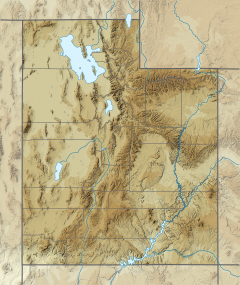| Haystack Peak | |
|---|---|
 Northeast aspect Northeast aspect | |
| Highest point | |
| Elevation | 12,020 ft (3,664 m) |
| Prominence | 660 ft (201 m) |
| Parent peak | Ibapah Peak (12,087 ft) |
| Isolation | 1.58 mi (2.54 km) |
| Coordinates | 39°50′52″N 113°54′18″W / 39.8477177°N 113.9049968°W / 39.8477177; -113.9049968 |
| Geography | |
  | |
| Location | Great Basin Desert |
| Country | United States of America |
| State | Utah |
| County | Juab |
| Parent range | Deep Creek Range Great Basin Ranges |
| Topo map | USGS Ibapah Peak |
| Geology | |
| Mountain type | Fault block |
| Rock type | Granite |
| Climbing | |
| Easiest route | class 2 via Indian Farm Canyon |
Haystack Peak is a 12,020-foot elevation (3,664 m) mountain summit located in Juab County, Utah, United States.
Description
Haystack Peak is the second-highest summit in the Deep Creek Mountains which are a subset of the Great Basin Ranges, and it is set on land administered by the Bureau of Land Management. The Dugway Proving Ground is northeast of the peak and line parent Ibapah Peak is 1.5 mile to the southwest. Topographic relief is significant as the east aspect rises 6,800 feet (2,100 meters) in six miles, and the west aspect rises over 4,000 feet (1,200 meters) in two miles. Bristlecone pine can be found on the peak's slopes, as well as spruce, fir, and aspen. Precipitation runoff from the mountain's west slope drains into Sams Creek, the northwest slope drains into Indian Farm Creek, and the south slope is drained by Red Cedar Creek. This landform's toponym was officially adopted in 1974 by the U.S. Board on Geographic Names.
Climate
Haystack Peak is set in the Great Basin Desert which has hot summers and cold winters. The desert is an example of a cold desert climate as the desert's elevation makes temperatures cooler than lower elevation deserts. Due to the high elevation and aridity, temperatures drop sharply after sunset. Summer nights are comfortably cool. Winter highs are generally above freezing, and winter nights are bitterly cold, with temperatures often dropping well below freezing. Alpine climate characterizes the summit and highest slopes.
| Climate data for Haystack Peak 39.8473 N, 113.9090 W, Elevation: 11,398 ft (3,474 m) (1991–2020 normals) | |||||||||||||
|---|---|---|---|---|---|---|---|---|---|---|---|---|---|
| Month | Jan | Feb | Mar | Apr | May | Jun | Jul | Aug | Sep | Oct | Nov | Dec | Year |
| Mean daily maximum °F (°C) | 26.2 (−3.2) |
25.7 (−3.5) |
30.8 (−0.7) |
35.1 (1.7) |
44.6 (7.0) |
56.5 (13.6) |
65.9 (18.8) |
64.4 (18.0) |
55.9 (13.3) |
43.5 (6.4) |
32.3 (0.2) |
25.9 (−3.4) |
42.2 (5.7) |
| Daily mean °F (°C) | 17.3 (−8.2) |
16.0 (−8.9) |
20.2 (−6.6) |
24.2 (−4.3) |
33.1 (0.6) |
44.0 (6.7) |
52.9 (11.6) |
51.7 (10.9) |
43.5 (6.4) |
32.5 (0.3) |
23.0 (−5.0) |
17.0 (−8.3) |
31.3 (−0.4) |
| Mean daily minimum °F (°C) | 8.3 (−13.2) |
6.2 (−14.3) |
9.5 (−12.5) |
13.2 (−10.4) |
21.7 (−5.7) |
31.5 (−0.3) |
39.9 (4.4) |
39.0 (3.9) |
31.1 (−0.5) |
21.6 (−5.8) |
13.8 (−10.1) |
8.1 (−13.3) |
20.3 (−6.5) |
| Average precipitation inches (mm) | 3.81 (97) |
3.95 (100) |
4.01 (102) |
4.45 (113) |
3.60 (91) |
1.69 (43) |
1.53 (39) |
1.49 (38) |
1.83 (46) |
2.61 (66) |
2.69 (68) |
3.46 (88) |
35.12 (891) |
| Source: PRISM Climate Group | |||||||||||||

See also
References
- United States Geological Survey topographical map - Ibapah Peak
- ^ United States Board on Geographic Names (1974), Decisions on Names in the United States, Decision List 7403, Department of the Interior, p. 24
- "Haystack Peak, Utah". Peakbagger.com. Retrieved August 25, 2022.
- ^ "Haystack Peak - 12,020' UT". listsofjohn.com. Retrieved August 25, 2022.
- "Haystack Peak". Geographic Names Information System. United States Geological Survey, United States Department of the Interior. Retrieved August 25, 2022.
- Utah Statewide Wilderness Study Report, Volume 2, Part 1, (1992), U.S. Department of the Interior, Bureau of Land Management, p. 31
- ^ Madeleine Osberger, Steve Cohen (1996), Adventure Guide to Utah, Hunter Pub., ISBN 9781556507267, p. 71
- Peel, M. C.; Finlayson, B. L.; McMahon, T. A. (2007). "Updated world map of the Köppen−Geiger climate classification". Hydrol. Earth Syst. Sci. 11. ISSN 1027-5606.
- "PRISM Climate Group, Oregon State University". PRISM Climate Group, Oregon State University. Retrieved October 6, 2023.
To find the table data on the PRISM website, start by clicking Coordinates (under Location); copy Latitude and Longitude figures from top of table; click Zoom to location; click Precipitation, Minimum temp, Mean temp, Maximum temp; click 30-year normals, 1991-2020; click 800m; click Retrieve Time Series button.
External links
- Haystack Peak: weather forecast